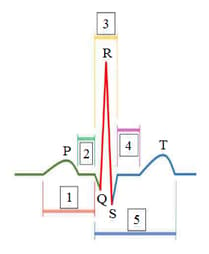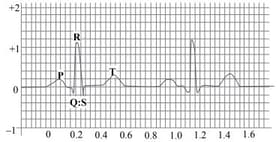The T wave on an electrocardiogram (ECG) represents repolarization.
Important Questions on Body Fluids and Circulation
Select the best option from the following statements:
(i) Frog is a poikilothermic
(ii) Frog does not have any coronary circulation
(iii) Heart is "myogenic" in nature
(iv) Heart is autoexcitable
| Column – I | Column – II | ||
| a. | Tricuspid valve | i. | Between left atrium and left ventricle. |
| b. | Bicuspid valve | ii. | Between the right ventricle and pulmonary artery. |
| c. | Semilunar valve | iii. | Between the right atrium and right ventricle. |
Recognize the figure and find out the correct matching?

Statement (S): The sinoatrial node is called 'Pace-maker'.
Reason (R): The sinoatrial node contains specialised cardiomyocytes and generates action potentials without any external stimuli.
The correct answer is
The diagram below shows a typical .

If the node is not functional, which of the following options correctly represents the changes seen in the ?
In the electrocardiogram, QRS complex stands for:
| Column – I | Column II | ||
|---|---|---|---|
| P – wave | Depolarisation of ventricles | ||
| QRS complex | Repolarisation of ventricles | ||
| T – wave | Coronary ischemia | ||
| Reduction in the size of T - wave | Depolarisation of atria | ||
| Repolarisation of atria |
Select the correct option
Assertion : Dub' is one of the sounds of the heart caused during a cardiac cycle.
Reason : The sound is due to closure of semilunar valves present at the bases of aortic arches.
Match the following related to the cardiac cycle.
| Column I | Column II | ||
| Cardiac Cycle | |||
| Atrial Systole | |||
| Ventricular Systole | |||
| Cardiac Diastole | |||
Match List I with List II.
| List I | List II |
| A. P-wave | I. Beginning of systole |
| B. Q-wave | II. Repolarisation of ventricles |
|
C. QRS complex |
III. Depolarisation of atria |
| D. T-wave | IV. Depolarisation of ventricles |
Choose the correct answer from the options given below:


